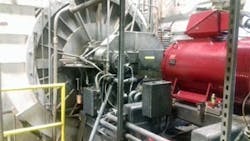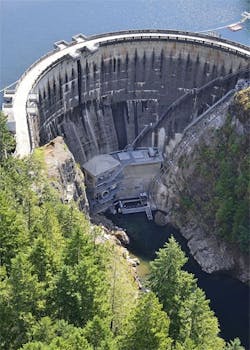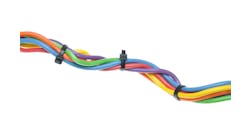Something old, something new, using both can save energy for you. And revising an old wedding poem can be the best way to express how traditional power-saving strategies are joining more recent methods from advanced process control (APC) and simulation to the latest digital, networking and Internet-based tools to develop energy-efficient solutions.
Of course, the common thread among all power-saving devices and energy-efficiency efforts is selecting the right devices and operations data for each application, and getting their results into the right eyeballs and hands as fast as possible for the best, most profitable decisions. However, it also helps if organizers and developers think beyond the old energy-as-accounting function, and let it become another valuable player in the data streams contributing to process control and optimization.
"In the past, energy efficiency meant better lighting, drives, soft starters and other low-hanging fruit, but over the last few years, we're increasingly controlling processes and power in ways we didn't before," says Kareem Suhwail, power and energy group manager at RoviSys (www.rovisys.com), which is a certified member of the Control System Integrators Association (CSIA) in Aurora, Ohio, and serves clients in the power, metals, glass, paper, pharmaceuticals, chemicals and other industries, typically by implementing micro-grids and boiler and chiller controls. "We're doing a lot of combined heat and power (CHP) plants to help users make steam and electricity more efficiently compared to buying it. They're also looking at more efficient equipment and processes because they're more aware of real-time energy costs, weather and other ambient conditions detailed by big data."
Suhwail reports that former users of smaller, packaged boiler systems are replacing them as part of a CHP process with heat recovery steam generators (HRSG) that deliver power and heat, while others are adopting the usual high-efficiency motors, variable frequency/speed drives (VFD, VSD), demand-response systems and peak-shaving devices. "However, users aren't just seeking more efficient power because their production is only so efficient, too. They're looking at their processes more holistically along with their utilities, and trying to more accurately control both," he says. "Many systems that were traditionally up to 60% efficient can easily be increased to 70-75% or more efficiency by moving to CHP, and that's a 10-15% improvement for the major university physical plants and other users doing it.
"We did an in-house CHP project for an Ingredion corn products facility in Canada, and installed a 20-megavolt ampere (MVA) CHP plant to replace their onsite package boilers, which dramatically increased efficiency, reliability and resilience beyond the power they were buying from the local utility. It's controlled by a S7 Portal PLC and WinCC HMI from Siemens, and uses components from Schweitzer Engineering Laboratories to integrate with the internal microgrid we installed. This 'enterprise smart grid' is layered on top of the CHP, and manages electricity and steam flow, as well as water and natural gas. They're all controlled by the PLC to give the manufacturing process what it needs, but still do it at the lowest cost."
Bob Sabin, consulting engineer with the Industrial Energy Solutions Group at Emerson Automation Solutions, adds that, "We're seeing a steady stream of people seeking support, energy surveys to monitor and mine data, energy monitoring information systems (EMIS) and cost reductions. Many times, users can't address the cost of raw materials and other expenses onsite, but they can decide if a process is too energy intensive. This is why there's no doubt that energy efficiency is becoming part of the overall process control mission of reducing or taking out variable costs."
Old reliables spin better
Just as it's more important to get accurate sensors and well-calibrated instruments in place before trying to analyze overall situations and plot better scenarios, many energy experts report it's preferable to size motors correctly, ensure onsite power quality, and install other basic energy-saving components and strategies before trying make gains with APC, simulations and other data analytics because most high-level, software-based solutions depend on the reliability of plant-floor hardware.
"Our standpoint is close to the factory floor, and this is where energy efficiency really starts," says Kenn Anderson, president of Nova Systems Inc., a CSIA-member system integrator in Milwaukee, Wis. "Software can do process and energy optimization, but you have to get the big-bang-for-your-buck improvements first because that's where the bulk of energy savings are. The process you're controlling has to be inherently efficient, and this means high-efficiency motors and sizing other equipment and processes properly.
"For example, if a technician puts a 20-hp motor on a pump that's only rated to take up to a 10-hp motor, it will be very inefficient because its impeller is running in a low-efficiency range of the motor. This is why we have to size motors properly and run them at full load where they're most efficient. Also, if you have fans or pumps that you know will always be running at full speed, then you may not need a VFD for them because drives only make sense if you're reducing or varying motor speed. We see a lot of unnecessary VFDs because many users think they always make motors more efficient, but they haven't checked if their motors will always be at full speed. To use a VFD when the load always runs at full speed wastes energy from the heat loss of the VFD."
Figure 1: System integrator Nova Systems installed a 500-hp AC Dyneo permanent-magnet (PM) motor from Leroy-Somer and Nidec on a whey evaporator at a cheese processing plant, and improved its efficiency from 90% with DC motor to 97% with the PM solution.
Source: Nova Systems and Nidec
Anderson reports it's also vital to evaluate constant-torque-load motors versus variable-torque-load motors, and determine which is best for each application. "If the speed of a constant-torque motor is reduced by half, its energy consumption will drop by half, but if the speed of a variable-torque motor is reduced by half, its energy consumption will be only 1/8 of what it was previously because it operates on a cube function," explains Anderson. "This can be important for a 10-hp fan that runs at half speed because it will only need to use 1.25 hp."
Anderson adds the 10-year-old push by the U.S. Dept. of Energy towards high-efficiency motors contained in the Energy Policy Act (EPAct) and Energy Independence and Security Act (EISA) spurred manufacturers and users to move beyond less efficient induction-asynchronous motors to more efficient permanent-magnet (PM) motors in recent years.
"We installed a 500-hp motor on a whey evaporator in a cheese processing plant about 18 months ago," says Anderson. "The old solution was a DC motor installed in 1992, but it was starting to fall apart. However, the cost of a new DC was extremely high and it was only 90% efficient, so they decided to put in the 500-hp AC Dyneo PM motor from Leroy-Somer and Nidec that was 97% efficient (Figure 1). The AC PM motor also has no brushes, so it also saves on preventive maintenance. Plus, the user no longer needs to switchover to a second motor while the original motor goes out for maintenance." The new motor runs also 24/7/365, and it's integrated with the plant's EtherNet/IP network and ControlLogix PLC from Rockwell Automation, which manages speed, but still allows manual oversight.
Variable speed prioritizes power
Beyond more-refined motors, most observers report the biggest contributor to energy efficiency in the past couple of decades has been the accelerating proliferation of VFDs and VSDs in the process and related industries.
For instance, to expand its production and quality to meet export demand, Thai Roong Ruang Sugar Group (www.trrsugar.com) in Bangkok has been implementing a sugarcane farm management system using IT and GPS technologies to link and share data between farmers and its new production center in Thailand's northeast Sakon Nakhon province. To construct the plant, TRR has partnered with Real Soluplus Co., Ltd. as EPC and ABB to provide the center's sugar mill automation system, which was scheduled for installation and commissioning in August-September 2017. ABB is supplying 18 low-voltage (LV) motors, three ACS880 multi-drives for the mills, one medium-voltage (MV) slip-ring motor for the shredder and two MV slip-ring motors for the cutters. All equipment will be controlled by ABB's Ability System 800xA control system.
“This is the second plant in Thailand where the new technology of individual, pinionless AC drives is installed on each rolling mill, enhancing the ability to transmit power independently to each mill, and allowing greater control and higher system efficiency," says Phimon Limlikhitagsorn, sales manager with ABB’s Robotics and Motion division. "This solution helps reduce initial investment and maintenance costs, increases energy savings at the same time, and provides the opportunity to further develop established milling concepts and gain valuable operational information that can be applied to future projects.”
Mark Urda, founder and president of Synergy Systems Inc., a CSIA-certified system integrator in Lisle, Ill., adds that, "Clients seeking energy efficiency in burners and combustion processes can gain 5% by using a mechanical economizer or 1-2% energy savings with tighter controls, and these are significant benefits. However, the biggest change in the past 40 years has come from VFDs because they're a much bigger help than dampers when used in applications like combustion air fans. VFDs can also replace control valves that cause pressure losses, and take advantage of curves in the pump laws, which basically state that: 1) flow is proportional to speed, 2) pressure increases as the square of speed, but 3) power increases as the cube of speed. These are where the big energy-saving potentials are, but they must be taken into account when sizing motors, along with fans and pumps that have headers with any other involved systems and may still need a control valve.
"For example, boiler houses usually have VFDs in two areas: the combustion air fan and the boiler feedwater pump. However, if the process is running at 150 psi, then the boiler feedwater header must be 20-40 pounds higher so its water can get into the system. We recently fixed an oversized pump at a Chicago-area medical center that was generating 300 psi, blowing it seals, and causing maintenance problems because its valve was clamped way down. We added a VFD, which reduced the head pressure appropriately, eliminated the maintenance issues, improved control, and meant longer life for the control valve."
Urda adds that Synergy's VFD philosophy is part of its 10-year-old Energy Patriot program, which is based on three principles: conserve by using power-saving devices like VFDs; optimize by systematically analyzing stack and systems for beneficial improvements; and generate additional energy by securing and optimizing waste heat from boilers and other processes.
Figure 2: Tacoma Power recently implemented ControlLogix PACs and PowerFlex drives from Rockwell Automation to automatically manage the powerhouse, two 1.8-MW generators, river outlet valve, fish hoist and other equipment at its Cushman No. 2 dam on the Skokomish River, which restored a local salmon migration route, and generates an added 3.6-MW of electricity for 1,700 homes.
Source: Tacoma Power and Rockwell Automation
Likewise, Tacoma Public Utilities and its Tacoma Power division provide more than half the city's electricity, and 90% of that power comes from hydroelectric generators and dams on rivers in western Washington state. However, it recently had to build a bypass for salmon around two dams, and add a new hydroelectric powerhouse to one—at the Cushman No. 2 dam located upstream of the Skokomkish River's north fork and downstream of the Lake Cushman reservoir (Figure 2). To add a river outlet valve, Tacoma Power needed to moderate its flow and duplicate river conditions for its fish collection station, install a powerhouse to generate electricity for 1,700 homes, and automate the whole facility for remote access and control.
Because they'd used Allen-Bradley ControlLogix programmable automation controllers (PAC) at seven other powerhouses, Tacoma Power's engineers decided to implement four at Cushman No. 2, including two controlling two 1.8-megawatt (MW) generators, one controlling most plant/powerhouse operations, and one controlling the fish hoist, tram and other collection equipment. The utility's operators manage the new powerhouse with one flow-control setpoint that's sent to the plant PAC, which automatically issues flow instructions to each generator and the outlet valve to ramp flow at a regulated rate, mimicking seasonal river flows. Distributed network protocol (DNP) and Modbus cards from ProSoft Technology interface with sensors, equipment and other systems at the powerhouse, and provide seamless Ethernet communications across multiple platforms. If one or both generators go offline, the plant PAC will immediately open the outlet valve to maintain uniform flow.
As for the hoist and tram, Tacoma Power needed precise control to move adult fish to the top and smolt back down, and opted for an Allen-Bradley PowerFlex 700 AC drive with TorqProve functionality to control the hopper when transferring control between the drives and the tram's mechanical brake. PowerFlex 70 drives and combination starters runs the other fish collection equipment. The drives were programmed with Allen-Bradley DriveTools SP software and Rockwell Software Studio 5000 Logix Designer software. As a result, because the utility restored the salmon's migration route, it's licensed to generate electricity for Tacoma until 2048, and also achieved its goal of producing 3.6 MW of extra hydropower.
"Since we can use the same software we used to program our controllers to also program and store our drive parameters, we save on commissioning time and can store our drive parameters and controller program in one file location,” says Ozan Ferrin, generation automation supervisor at Tacoma Power. "With one push of a button from our control center, we can ramp flow up or down, which is more accurate than doing it manually and saves us the costs of on-site staffing."
Michael Tay, advanced analytics product manager at Rockwell Automation, adds that, "Different users and industries have different energy efficiency strategies based on how energy-intense and how commodity-based they happen to be. Power generation, petrochemical and cement use more power, so they're first to use APC and other ways to save energy. Pharma and food are less energy intensive, so they look for control improvements and less-costly ways to save energy. However, we suggest any energy-intense industries not only consider new equipment because a new kiln costs a lot more than optimizing (doing the most with) existing equipment.
"In general, everyone's thinking more holistically about energy because they now have the data and analytics to step back, see how much they're spending per pound of product produced, and perform MPC. There are also staged-workflow projects and data-driven, better startup/shutdown decisions that aren't based as much on outdated, heuristic rules and guesses."
Pneumatics push down costs
Despite the prejudice that pneumatics are old-fashioned and slow compared to electronics, some advocates report they can also be recruited to reduce energy expenses if properly evaluated and applied.
"Major end users like Pfizer and Nestlé are fully aware of how much they spend on compressed air and energy, so when they look to add a process skid or production line, they don't just look at throughput, but put hard targets on the energy efficiency of the equipment they buy," says Craig Correia, process industries director at Festo. "At the same time, system integrators and OEMs use energy efficiency as a competitive marketing tool, and clearly state reductions of compressed air use in their latest designs. To aid these efficiency efforts and optimize design of plant automation, Festo offers an energy audit and efficiency service and tools for design and operations phases. This service finds leaks and recommends improvements in design, including free tools to properly size valves and automation. Festo will also help identify the most beneficial locations for flow sensors and pressure sensors."
Correia adds that one good way to monitor and manage compressed air costs is to supplement the typical upstream pressure sensor on an air preparation unit with a flow sensor that can continuously measure volumetric flow and air consumption in real-time. "By monitoring this regularly and comparing it to a baseline, you can create a simple alert when air consumption increases due to an air leak or component degradation," explains Correia. "The latest innovation from Festo is driven by both efficiency awareness and Industry 4.0. The VTEM Motion Terminal with piezoelectric technology uses apps that allow the controller to switch from a discrete valve to a proportion valve, and measure air leakage from one pneumatic valve."
Likewise, Aichi Forging Co. of Asia (AFC) in Santa Rosa, Laguna, Philippines, manufactures transmission-related parts for automakers, but recently sought to cut electricity expenses by automating controls and optimizing its air compressors. “Manually adjusting the air supply to meet the need of the production line was difficult," says Jaime Fajardo, maintenance department manager at Aichi. "However, if the compressors are put in automatic operation mode they can unload, which leaves the motor running even though the compressor isn't supplying air. As a result, the energy driving the compressors sometimes didn’t match the load at the production line. Also, we didn't have enough information on the amount of air used in the factory and the power consumed by the compressors, which made it even more difficult for us to control the air supply properly.”
Initially, Aichi considered replacing its aging compressors with more efficient versions, but eventually decided to install ENEOPTcomp compressor optimization controls, Harmonas-DEO central monitoring and control system, and Bravolight pressure sensor from Azbil Corp. Installed in March 2015, Harmonas-DEO starts as many of Aichi's six compressors as needed to supplement the plant's air supply when Bravolight detects increased air use on the production line.
After introducing ENEOPTcomp, Aichi's staffers found they could typically run just three compressors because they were operating more efficiently due to Harmonas-DEO controlling starts and stops of the other three according to production air needed in real-time. "These efforts produced a 10% reduction in power consumption per month," adds Fajardo. "We've also reduced operator workloads on the production line because manual compressor monitoring, starting and stopping is no longer needed. In addition, with Harmonas-DEO, we can track trends in air use, accumulate data, and visualize trends over the long term.”
Because compressed air costs keeps mounting and chronic leaks dilute its efficiency, however, Nova Systems' Anderson reports that servo-based devices and other electronics have been replacing pneumatics in many applications. "Instead of pneumatic cylinders with process valves throttling, users are choosing electronically operated servo cylinders with ballscrews or belts," he says. "They're more costly to begin with, but they're most cost-effective in the long run because they reduce the constant demand for compressed air. We've been getting more inquiries from users about them."







